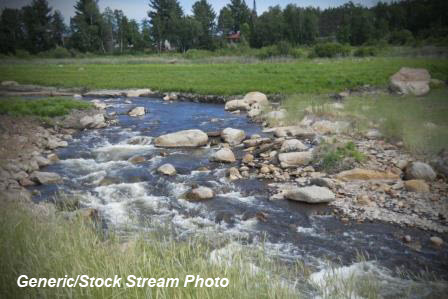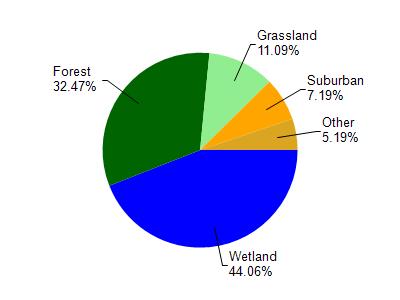
1.58 Miles
9.60 - 11.18
Macroinvertebrate, Cool-Warm Headwater
2010
Unknown
Douglas
No
No
No
Fish and Aquatic Life
Overview
Copper Creek flows generally north off the Superior escarpment into the Nemadji River. Most of the stream is assumed to support a balanced fishery. The reach beginning from the town road crossing in section 25-26, T47N R14W and extending downstream about two miles to a warm water tributary is considered Class II trout waters reported to support brook trout. The unnamed tributary flowing north to Copper Creek in section 22, T27N, R14W is classified as supporting a Class I reproducing brook trout population and is listed as an exceptional resource water. The tributary has an extremely high gradient of 145 feet per mile, but has a relatively small base flow. The bottom is mostly unstable sand with small amounts of gravel. Precipitated iron deposits cover most of the stream substrate at the headwaters. About an eighth of a mile of the stream flows within Pattison State Park. Both creeks are considered flashy based on in-stream debris and eroded banks.
From: Turville-Heitz, Meg. 1999. Lake Superior Basin Water Quality Management Plan. Wisconsin Department of Natural Resources, Madison, WI.
Date 1999
Author Aquatic Biologist
Historical Description
Copper Creek is an approximately 11.2 mile tributary that flows north off of the Superior escarpment. The stream passes through the northern end of Pattison State Park on its way to the Nemadji River. This stream has been assumed to support a balanced fishery and its current and attainable uses are listed as a Class II trout stream, although it is unclear whether or not it supports that listing in all reaches. The reach of Copper Creek beginning at the confluence with an unnamed warmwater tributary (WBIC-2836600) at ~river mile 7.2 and extending upstream about two miles to Leggate Road in section 25-26, T47N R14W is reported to support brook trout. A baseline fish survey conducted at Baumgartner Road (~river mile 5.5) in 2006 in the reach downstream of this section did not result in sampling any brook trout. Overall, very little biological assessment has been performed on Copper Creek.
Date 2011
Author Aquatic Biologist
Condition
Wisconsin has over 84,000 miles of streams, 15,000 lakes and milllions of acres of wetlands. Assessing the condition of this vast amount of water is challenging. The state's water monitoring program uses a media-based, cross-program approach to analyze water condition. An updated monitoring strategy (2015-2020) is now available. Compliance with Clean Water Act fishable, swimmable standards are located in the Executive Summary of Water Condition in 2018. See also the 'monitoring and projects' tab.
Reports
Recommendations
Monitor Fish Community
Sampling of the fish community and habitat evaluation of Copper Creek is recommended to more appropriately identify current and potential trout stream reaches (presence/absence) in Copper Creek, and how to best designate non-trout water. Assessment for potential impacts of beaver to the Copper Creek fishery could also be considered.
Management Goals
Wisconsin's Water Quality Standards provide qualitative and quantitative goals for waters that are protective of Fishable, Swimmable conditions [Learn more]. Waters that do not meet water quality standards are considered impaired and restoration actions are planned and carried out until the water is once again fishable and swimmable
Management goals can include creation or implementation of a Total Maximum Daily Load analysis, a Nine Key Element Plan, or other restoration work, education and outreach and more. If specific recommendations exist for this water, they will be displayed below online.
Monitoring
Monitoring the condition of a river, stream, or lake includes gathering physical, chemical, biological, and habitat data. Comprehensive studies often gather all these parameters in great detail, while lighter assessment events will involve sampling physical, chemical and biological data such as macroinvertebrates. Aquatic macroinvertebrates and fish communities integrate watershed or catchment condition, providing great insight into overall ecosystem health. Chemical and habitat parameters tell researchers more about human induced problems including contaminated runoff, point source dischargers, or habitat issues that foster or limit the potential of aquatic communities to thrive in a given area. Wisconsin's Water Monitoring Strategy was recenty updated.
Grants and Management Projects
| Project Name (Click for Details) | Year Started |
|---|
|
|
Monitoring Projects
| WBIC | Official Waterbody Name | Station ID | Station Name | Earliest Fieldwork Date | Latest Fieldwork Date | View Station | View Data |
|---|
| 5501150 | Unnamed | 10033041 | Unnamed | | | Map | Data |
| 2836100 | Copper Creek | 10033041 | Unnamed | | | Map | Data |
| 5501150 | Unnamed | 10036152 | Copper Creek - Area of Open Water | 7/12/2009 | 7/15/2010 | Map | Data |
| 2836100 | Copper Creek | 10036152 | Copper Creek - Area of Open Water | 7/12/2009 | 7/15/2010 | Map | Data |
|

Watershed Characteristics
Copper Creek is located in the St. Louis and Lower Nemadji River watershed which is 159.67 mi². Land use in the watershed is primarily wetland (44.10%), forest (32.50%) and a mix of grassland (11.10%) and other uses (12.40%). This watershed has 432.66 stream miles, 8,490.75 lake acres and 26,945.85 wetland acres.
Nonpoint Source Characteristics
This watershed is ranked Not Ranked for runoff impacts on streams, Not Available for runoff impacts on lakes and Low for runoff impacts on groundwater and therefore has an overall rank of Low. This value can be used in ranking the watershed or individual waterbodies for grant funding under state and county programs.However, all waters are affected by diffuse pollutant sources regardless of initial water quality. Applications for specific runoff projects under state or county grant programs may be pursued. For more information, go to surface water program grants.
Copper Creek is considered a Macroinvertebrate, Cool-Warm Headwater under the state's Natural Community Determinations.
Natural communities (stream and lake natural communities) represent model results and DNR staff valiation processes that confirm or update predicted conditions based on flow and temperature modeling from historic and current landscape features and related variables. Predicated flow and temperatures for waters are associated predicated fish assemblages (communities). Biologists evaluate the model results against current survey data to determine if the modeled results are corect and whether biological indicators show water quaity degradation. This analysis is a core component of the state's resource management framework. Wisconsin's Riverine Natural Communities.
Cool (Warm-Transition) Headwaters are small, sometimes intermittent streams with cool to warm summer temperatures. Coldwater fishes are uncommon to absent, transitional fishes are abundant to common, and warm water fishes are common to uncommon. Headwater species are abundant to common, mainstem species are common to absent, and river species are absent.